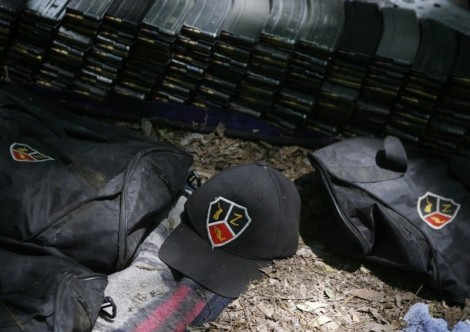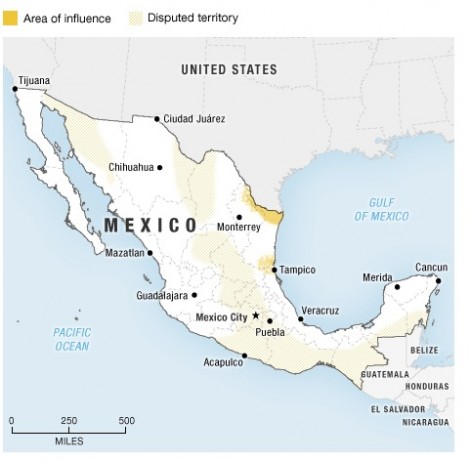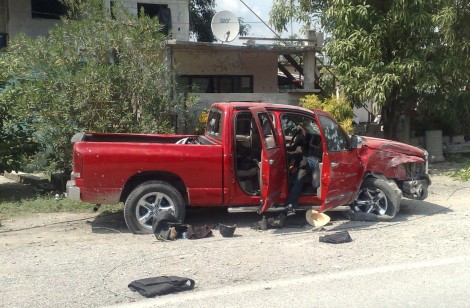
The “Z” is for “Zetas”
It’s been a long, long time since my last article, but believe me it’s not because there hasn’t been any news. If anything, it’s because too much has been happening too fast to really explain the situation―even by Mexico’s Drug War standards, the news here is a fast-moving target and getting faster―and bloodier―by the day. I haven’t been able to finish a fucking paragraph without some new and bigger development changing the game.
If you’ve been paying attention to Monterrey’s drug wars (that’s my beat), then you probably heard about how there are roadblocks all over the city, and how there’s a kind of civil war going on, pitting the Gulf Cartel against their former armed wing, Los Zetas. And while it’s true that this mostly accounts for all the recent carnage, to understand the recent dark turn of events, you have to backtrack a bit.
A few years ago Monterrey was synonymous with cabrito and big business. It’s a growing city and (was) one of the most peaceful in Mexico. Nothing worth remembering went on during the 1990s; drug-trafficking in the north of the country was the pretty much dominated by Sinaloans in the west and Tamaulipans to the east, while the occasional social unrest and pseudo-insurrections were relegated to the south… and big city crime was left to one of the largest ghettos in the Western Hemisphere, Mexico City.
“Progress” was the word everyone associated with the city of Monterrey; most of the time that word means flat boredom, but it also means money, and in Monterrey’s case, lots of it. During the 90s, this sort of “progress” started expanding out of Monterrey, into suburbs like San Nicolas, Guadalupe, Cadereyta, Juarez and Santa Catarina. “Greater Monterrey” is still growing, the fucking traffic gets worse every day.
So how did we go from stale suburbia to the dangerous hellhole that is Monterrey today? How did it get so bad that the children of employees of the fortified US Consulate in Monterrey were evacuated to the US?
The answer, drumroll: The Zetas! This merry band of murderers-for-hire has been creating mischief all over Mexican territory, and even some areas of Texas if you believe the DEA reports.
It was around 2005 that the Zetas first started making their move to enter the plaza of Monterrey–if there are any readers from Monterrey here, then you will remember shit like the grenade attack in the now-closed El Punto bar and the subsequent execution of “El Dany-boy”, a Mexican mafia contact of the Sinaloa Cartel, who was hunted down by the Zetas. They found him at a poolhall, drinking Tecates and playing with some amigos. They emptied an entire R-15 clip into his face–but his amigos were spared. That’s one of the differences between 2005 and now. These days they would’ve sprayed the whole group.
In the beginning there were only about 40 Zetas, but they were trained, disciplined, and eager to move up. The Zetas started taking over Monterrey very quickly by taking out one of the Beltran brothers’ security rings. Two former Ministry cops, the brothers Jaime and Javier Valdez, controlled a small group of sicarios (hit men) led by “El Calabazo”, who were all hunted down and killed one by one with surgical precision between 2005-2006. The Zetas soon reached an agreement with the Beltran Cells in San Pedro, led by Hector Huerta, the real power in the region.
Okay, at this point, the first two questions that pop into an American’s head (and Mexicans’ who are oblivious to the drug war or just ignore it) are: 1. “Who or what are the Zetas?” and 2). “Are the Zetas behind the recent ‘narco-insurgency’?”
I can answer the second question easily: There is no insurgency. That sort of thing does not exist. Period.
But to answer the first question, I have give you some history.
Los Zetas started out as an elite Special Forces unit–or GAFE–created and trained in the School of the Americas (in the USA), with counter-insurgency in mind: Specifically, to combat the 1994 Zapatista Army of National Liberation insurrection in Chaipas. A few years later, at the turn of the millennium, GAFE units found themselves with no insurgencies to fight. So they were re-trained for drug-interdiction operations and were sent to Tamaulipas to capture the capos and disrupt narcotrafficing operations in the region. One of those GAFEs was headed by a man named Arturo Guzmán Decena, who would go on to be known as “Z-1”–the leader of the Zetas. Z-1 realized there was a lot more money helping the traffickers than trying to police them, and ended up as the personal escort of Osiel Cardenas. Nicknamed “The Friend-Killer,” Cardenas was just starting to take control of the leaderless Gulf Cartel around 1998-1999. Hiring elite soldiers was his way of consolidating power.
 Zetas territory…
Zetas territory…
And that’s how it all began: Bored, over-trained professional soldiers going rogue and working as hired killers for the Gulf Cartel.
Z-1 didn’t last long; he was ambushed and killed in 2002 in Matamoros, Tamaulipas, during a big Army operation. They cut off the head but the Zetas’ body kept growing.
Around these troubled times, Chapo Guzmán, leader of the Sinaloa Cartel (named the 41st most powerful man in the world by Forbes in 2009), was expanding his own drug empire. That expansion included Nuevo Laredo, the busiest land-crossing of the Mexico-US border, known as “the jewel of the crown” of the drug trade.
Trafficking is an exercise in probability. The trafficker’s job to better those odds through upping the volume: increased shipments, routes and bribes. So if in a certain border-crossing you calculate that 6 out of 10 cars carrying drugs will make it across the border, because not every car can be checked, you can better those odds to 8 or even 9 by bribing the customs officers, hiding the product better, or building a tunnel under the border.
Nuevo Laredo has tons of traffic every day. That means you can move more product and will have more probability of reaching the hearts & minds of American drug-users. Insatiable demand plus unending supply equals unstoppable market force. It’s economics, stupid.
But it’s also war, at least in this business―and the war was between Cardenas and Guzman.
Cardenas, wanting to protect and enhance his odds, ordered his Zetas to Nuevo Laredo. Their job was to protect the boss’ shipments from Guzman’s expansion, which was being led by Edgar Valdes Villarreal, “La Barbie,” the recently captured sicario of sicarios (“King of the Contract Killers”) and the man who knows every dirty little secret of the current drug war.
The Zetas set up an extortion network on every illegal business in Nuevo Laredo: drug dealers, trailer-truck transport companies, illegal betting (palenques), whorehouses and smugglers of all trades. The Zetas were getting rich and learning the trade―the no longer depended on their cartel boss. They could now fund themselves–and so they did. They expanded their tax-collecting operations to other cities, mainly into the northeastern states of Coahuila and Nuevo León.
From 2003 to 2008 they went from a regional gang to nationwide organization.
The expansion was orchestrated by Nabor Vargas García, “El Débora”, an army corporal who was part of the presidential guards until 1999, when he was recruited by Z-1 to form part of the original Zeta escort team. Most of the founding Zetas members–the original 40–were trained elite soldiers who received instruction in radio communications, counter-insurgency and drug-interdiction. But the Army forgot to add a few ethics lessons into the education mix. And that was a big fucking mistake.
Nuevo Laredo soon became a 2-word textbook lesson for the Zetas: First word is “EXPAND”, which means going into a city, subduing the local criminal gangs, creating a route for illegal trafficking, and taking rivals out of the game―with extreme prejudice. The second word: “CONTROL”, which means setting up a radio-communications network, organizing safe-houses, and setting up a network of informants, or “halcones” (“hawks”). In essence, the Zetas would create a big, city-wide extortion racket combined with a 24/7 real-time human intelligence network. It’s like a police state but done by criminals. And this is why the Zetas are so. fucking. scary.
But even with all their military-style innovations in the field of crime, the Zetas were no narcos–more like glorified hitmen or extortionists. The Zetas had the weapons, but not the contacts or the infrastructure to support import-export drug operations.
All that changed in 2008, when Alfredo Beltrán Leyva, “El Mochomo”, head of the most powerful narco-cartel in the country, was captured in Mexico City. The Federal Government claimed it was all part of a long, well-planned intelligence operation–which is bullshit, let me tell you. When a capo like this is captured so cleanly, usually it means something dirty, foul play.
Everyone who knew a little about the drug war and its main players knew that: A) “El Mochomo” was betrayed and B) Arturo Beltran was going to shit bricks. Arturo blamed “El Chapo” Guzman, who has become a goddamn paranoiac in recent years. (To be fair to El Chapo, big capos tend to be violent paranoiacs and you can thank a healthy cocaine habit for helping that.) And Arturo was probably right. It probably was Guzman who gave up “El Mochomo.”
Arturo Beltran was now angry enough with Guzman to make a deal with the Zetas. They’d already negotiated a truce with the Beltran brothers in Nuevo Laredo. By 2007 the truce was taken to national-scale.
“El Chapo” Guzman wrecked all that. You read a lot of articles making him out to be a very smart and business-savvy man. But Guzman made a very stupid move when he decided to give up Alfredo and piss off Arturo Beltran.
Arturo Beltran was the man the Zetas needed, the one who could open each and every door. With the Colombian contacts that Arturo Beltran gave them, and an infrastructure in place, “La Ruta Zeta”, the gang entered the Big Leagues, consolidated into their own Cartel and became real narcos.
Where was Cardenas’s Gulf Cartel while all this was happening? After Osiel was deported to face the American justice system, the Gulf Cartel’s leaders were little brother Ezequiel Cardenas and “El Coss”. The problem was that the Zetas, led by Heriberto Lazcano “Lazca” and Miguel Angel Treviño, or “Z-40,” never respected the Gulf Cartel’s new leaders. They figured that they only owed their loyalty to Osiel and no one else. Fighting grew in 2009 and exploded into the 2010 into a full-on war between the Zetas and the Gulf Cartel for control of the routes that they had formerly shared.
The Gulf Cartel evened out the odds a little when they formed an alliance with the Sinaloa Cartel, who themselves had already allied with a pair of organized crime groups from Michoacan: the Milen9io Cartel led by the Valencia family, a more traditional organization in the vein of the Sinaloans; and the Michoacan Family, a wayward cartel created by the Zetas that turned on them and became the biggest producers of synthetic drugs in the country, from Ecstasy to Crystal Meth.
Since that shit all blew up, these days all you hear about if you’re here in the northeast is “kidnappings” followed by “shootouts” followed by “massacres.” I can’t really speak for what’s going down in Tamaulipas because no information is coming out from there– unless it’s about car bombs, a big new trend that looks like it’s here to stay, unfortunately.

A few Zetas killed in a shootout with the federales…
All that shit got into Nuevo Leon, the state where Monterrey is located, in spite of the Military efforts to stop the movements, showing that what happens up north in Tamaulipas has a ripple effect down in Nuevo Leon– and vice-versa. First it was the rural towns with rumors of big convoys of SUVs and double-cabin pickups cruising around, full of guys armed to the teeth; then they moved into downtown Monterrey– an endless flood of Zetas who’d been kicked out of Tamaulipas, if you believe the cops.
I already lost count of the number of narco-related murders in “Greater Monterrey,” but officially it’s nearing 400, and in reality it must be closer to 7- 800. It’s THAT bad. That’s close to a 1000% rise in murders. Not even during the fight for the plaza in 2005 were things this fucked up.
Monterrey went from to suburbia to shithole and then into hellhole category in less than a year, and it’s getting even worse. In the last two weeks there’ve been two shootouts between Zetas and the Army. The first one left 28 Zetas dead on the road in General Treviño, Nuevo Leon, plus 5 more in Juarez the next day, and 22 the next week on Mier City, Tamaulipas, on the border with Nuevo Leon. And that’s not counting all the individual executions between the battles. Nearly every day there are grenade attacks against police headquarters of different municipalities and state prisons.
That’s leaving out the mass graves, rural training camps for sicarios, the assassination of a local mayor by Zetas dressed as Federal Police, and all kinds of other stuff that makes life in Monterrey an adventure whether you want it to be or not.
You might think that at this rate, the Zetas will soon be wiped out, right? Well, that’s what the Americans say about the Taliban in their attrition doctrine of kill-kill-kill, and they follow it like gospel. But the Zetas, even without as many soldiers in their ranks, have a near-infinite recruitment pool of dirt-poor young men without no jobs or education―just plenty of rage, a dream of getting rich quick, and the need to belong to a cool outfit.
Their need to belong is satisfied with the power that comes from an assault rifle and a Nextel, and the money is enough to afford utopia in Mexico, if even for just a few years. This is the sentiment of a lot of young men in Mexico, not just the poor but also the middle classes who would rather die young and rich than poor and old. Beyond all the layers of the drug war, what is found at the core is a class war, and when rich and poor go to war it´s always the general population who get fucked the hardest.
Nuevo Leon/Monterrey is the perfect example of how zetas inflitrate into a society and how difficult it is to extirpate the little tumors, and when they have as big a protection network (Municipal/state police) as they do in Monterrey it’s pretty much impossible. When I heard about a new anti-zeta alliance I was genuinely excited that there was finally some light at the end of the tunnel, that it was just a matter of time for the war would end. Now I don’t think this is going to stop, even if they capture Lazca or Z-40. The illegal movement of people or merchandise through borders, all-over the world, is as natural a phenomenon as rain.
But you don’t need to start worrying about a narco-insurrection in Mexico. That’s just a way to get more votes and money for politicians on both sides of the border. An insurgency implies a challenge to the authority of the state; the narco war is more about protecting trade routes. There´s also scare-talk about a Colombianization in Mexico by some American politicians. First of all, make up your minds, would ya? First you tell the Mexican Government to fight the drug cartels to avoid a situation like Colombia in the 1980s then you tell us to follow the example of Colombia–how they successfully fought the Colombian cartels with the help of the US through Plan Colombia.
If Plan Colombia is so good, why is so much cocaine reaching Mexico? If the objective is to stop the northward flow of cocaine, it’s failing miserably. In Colombia there is talk between journalists that drug traffic in Colombia is officialized, meaning controlled or regulated by the Government, just like the heroin trade in Afghanistan.
But that’s a story for another day. I’m talking about Monterrey/Nuevo Leon here, and I don’t see any answer coming at all. Even if a few big bosses are captured or killed, the cartels will just fragment, fight, form new alliances―and it will all start over again.
Pancho Montana is an eXiled Special Mexican War on Drugs Correspondent.
As a native of Monterrey, Nuevo Leon, located in northern Mexico, Mr. Montana lives in Gulf Cartel territory. That means the streets belong to the Zetas, a paramilitary organization trained by the Yankees and hired by the Gulf Cartel to keep things civilized and business booming.